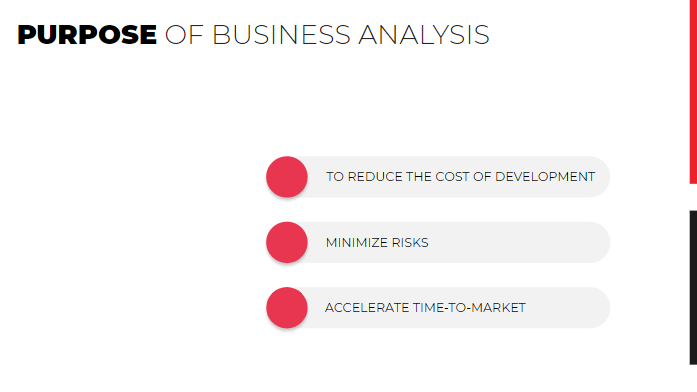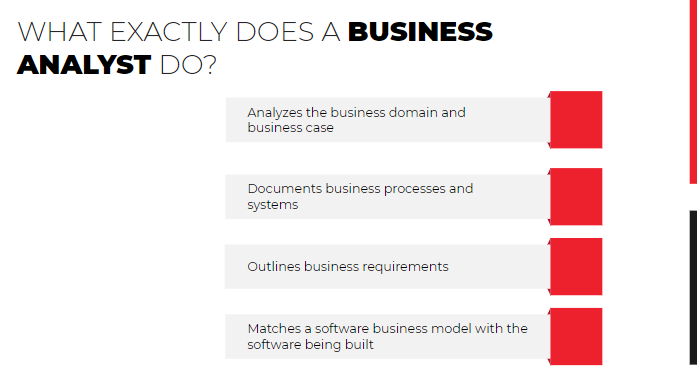Why is Business Analysis important in software design?
In this article, we cover the role of the business analyst in the software development lifecycle, what business analyst actually does within the project, and how you can measure his performance.
The lack of good business analysis before the start of a project can lead to failure. Business analysis is an important step in creating software for a company so we decided to write about what the role of a business analyst (BA) is in a project and why this person is important for the successful development of software that will be used in the business.
What is Business Analysis?
Despite the simple term, business analysis is more than just two words. Business analysis is the study of the specifics of the business, its current problems, tasks, and needs, as well as the expectations of shareholders and ways to meet these expectations and solve current problems using software solutions.
The business analysis becomes even more important in times of crisis because we also have to analyze the unpredictable market forecast and provide backup strategies for the customer if the situation changes.
What is the purpose of Business Analysis?
The purpose of business analysis is pretty clear.
- The first goal is to get an impression of the business in real-time, to determine the starting point before developing a solution.
- The second goal is to understand what needs to be created, and what specific functions will help solve the client’s current problem.
- The third goal is to form an approach to the solution development while minimizing risks and costs, and maximizing value and utility.
What are the types of Business Analysis?
There are more than 50 business analysis techniques, but here we list the main ones that allow us to get a fairly complete impression of the business, and draft a preliminary picture of a solution that will solve the current business problem.
- Interviewing stakeholders and decision-makers is the first stage of business analysis, and one of the business analyst’s key responsibilities. At this stage, it is necessary to understand the essence of the client’s problem, ask him to share his vision, and also get more detailed information about project deadlines, milestones, collaboration tools, and workflow preferences.
- A requirements workshop involves drawing up a list of the client’s requirements and wishes for a future solution. At this stage, it is necessary to make sure that the client and the team working on software development truly understand each other.
- Prototyping is the best technique to visualize the software product and receive quick feedback on its design and usability. What’s more, it is an indispensable approach when developing a project using the Lean methodology, which involves discussing all details of the project and thoroughly validating all functions before starting development.
- At the functional decomposition stage, the whole process is broken down into smaller subtasks in order to analyze each one, as well as create a preliminary estimate of how much time, effort, money, and resources will be needed to implement the solution.
- Non-functional requirements analysis is necessary to analyze legal requirements, such as Health Insurance Portability and Accountability Act (HIPAA) or General Data Protection Regulation (GDPR) regulations to create a project that will meet those guidelines.
- Scenarios, use cases, and user stories are necessary at this stage to clearly articulate how the system will work, exactly how it will solve the current business problem, and what the developer will do to solve it.
What exactly does a Business Analyst do?
Having analyzed the basic techniques of the business, the business analyst job description becomes more clear. These are his or her main responsibilities.
- Analyze business needs
- Define a business case
- Elicit information from stakeholders
- Design requirements
- Communicate with the design, development, and management teams to keep everyone on the same page with the product vision
- Validate solutions
- Test quality
As you can see, the role of the business analyst in the software development life cycle is quite important. A business analyst works as an intermediary between a customer’s business and its development team. What’s more, the active participation of this specialist is mandatory when the project is developed according to Agile principles especially in crisis times when the market situation is not stable.
What is the difference between a Business Analyst and a System Analyst?
Let’s draw a clear line between the role of a system analyst versus a business analyst.
- A system analyst answers the questions of how the system works now.
- A business analyst answers the questions of how the system should work to solve the client’s problem.
What are the 3 most important skills of a Business Analyst?
The business analysis specialist should have the skills, knowledge, and practices needed, so he or she can define the three most important issues that need solutions.
Communication skills. A business analyst should be communicating 60% of his working time. This person is responsible for providing a clear understanding between a customer and the development team.
Problem-solving skills. Very often the customers have some misunderstandings about what they want to see in the final result. This is called an “XY problem.” If a customer has problem X, but needs help with the Y part of the problem because he or she thinks that it will work, but is not sure. At this time, a business analyst should be able to separate one problem from the other and find a way to deal with each of them.
Critical thinking and analysis skills. It is impossible to analyze or suggest solutions without these skills.
How to evaluate the performance of a Business Analyst?
It is quite difficult to assess the contribution of a business analyst for a project because his/her work cannot be measured by tangible indicators — for example, the amount of written code that will be needed. If you manage to come to a consensus with the team regarding the solution that needs to be developed, and you are fully satisfied with the expected functionality, as well as the time and money costs, then the business analyst has done his part of the work professionally and correctly.
Conclusion
Do you still doubt the need for high-quality business analysis and a highly competent business analyst specialist? At Cprime, we have no doubts. That is why we offer a comprehensive approach to web and mobile project development paying close attention to the business analysis process and the best solution/s possible. Let’s find out how to solve your business problem with software development, and do it in the most economic way possible with our skilled team!





